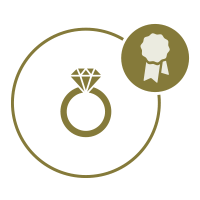Ethical, sustainable and slow fashion is mentioned very often nowadays. But most of the time, we talk about clothes, shoes and other fashion accessories. But what about jewellery? For example, the production of a single ring makes up to 20 tons of waste. But it’s not just about waste. In most cases, metal mining and processing are far from fair and resembles more of modern slavery.
Traditional gold mining is very harsh on nature. In fact, it is the most environmentally destructive kind of mining. It is either done by corporations in a country, where gold is mined while people are starving, or it comes from small, often family-run mines where ‘miners’ do not have much knowledge and after they carelessly spend the mercury on themselves and their surroundings because they know nothing more and they need money.
Ecological risks of gold mining
The hydrometallurgical process of gold mining from low-purity ores is a very risky process from an ecological point of view. The amount of cyanide solutions in tonne to 100-ton doses represents a huge risk in case of an accident. An example is the catastrophic contamination of the Danube with cyanides and heavy metals in Baia Mare in January 2000. That was a massive natural disaster – hundreds of tons of fish and other animals were killed and a large area of nature was, and still is destructed. Similar accidents have happened several times in the USA or South American Brazil when the Amazon River was contaminated.

Another problem is the use of metallic mercury for amalgamation gold mining, for example in Mongolia, South America or Africa. There are also significant problems with the appropriate deposition of thousand-ton quantities of leached rock and the agricultural use that is currently practically impossible.
Due to the potential risks of using cyanides, new methods are being developed, such as leaching in thiosulphate solution or thiourea. For now, more extensive use of this method is not possible because of its costs, which is also connected to the difficulties with the extraction of leached gold.
What are blood diamonds?
Blood diamonds (also called conflict diamonds) are diamonds mined in war zones and areas controlled by rebels that are opposed to internationally recognized governments. These rebels sell blood diamonds and use the money to buy weapons and to fund military actions against governments. The illegal sale of Blood diamonds has produced billions of dollars and has fund civil wars in many African nations, such as Sierra Leone (conflict ended in 2012), Angola, Liberia and the Democratic Republic of Congo (DRC). Innocent men, women and children are very often forced to produce these diamonds and are working in bad conditions. This is the main reason why they call them “blood diamonds”.
The United Nations and other groups are continuously working on blocking the entry of blood diamonds into the worldwide trade. This approach is known as the “Kimberly Process”. This means, that every nation has to certify that all the rough diamonds exported are produced through legal mining and sale. The Kimberly Process has significantly reduced the number of blood diamonds on worldwide markers and The World Diamond Council estimates that almost 99% of all diamonds are nowadays free of conflict.
Sustainable jewellery
Sustainable jewellery is jewellery manufactured in a way, that helps to achieve the economic, social and environmental sustainability of the places, where the materials for the product were mined and the product was manufactured.
As said before, mining and producing jewellery has many negative effects on nature. You can simply help it a bit by buying sustainable jewellery. And where can you buy gold sustainable jewellery you might ask? Here is a list of brands that sell ethical and sustainable jewellery.
How to buy ethical and ecological jewellery
People normally don’t buy expensive jewellery every day, so it’s not difficult not to rush and choose a brand that meets ethical and environmental standards.
You can consider the following aspects:
- The materials from which the jewellery is made (precious metals and stones) should be obtained ethically and be Fairtrade or Fairminted certified.
- Jewellery can also be made from recycled materials, such as older jewellery. Precious metals can also be produced from old electronics.
- Jewellery production itself should be ethical and jewellery should be created in places where human rights are respected and employees are fairly rewarded for their work.

Alternatives to Ethical and Fairtrade Jewelry
If new ethical jewellery is unavailable to you for any reason, several other eco-alternatives will allow you to buy a new piece of jewellery.
First of all, we have the opportunity to buy “second-hand” jewellery, which you can find not only in bazaars but also in various smaller goldsmiths.
Jewellery from independent local jewellers is also a great option. You can buy pieces that are often handmade and in a small amount. However, it must be taken consciously that the materials that are used often do not come from fair sources.





